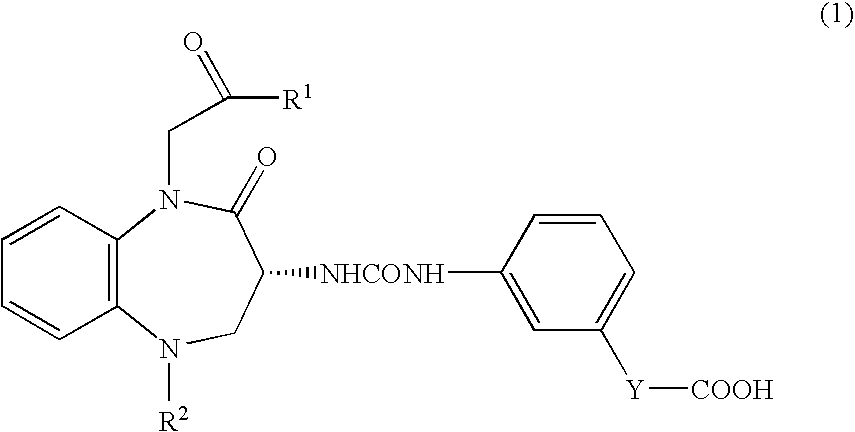Antitumor Agent
a technology of anti-cancer agent and anti-cancer agent, which is applied in the direction of biocide, heterocyclic compound active ingredients, drug compositions, etc., can solve the problems of reducing the dosage form of the respective pharmaceutical agent, restricting the interval or period of administration of such a chemotherapeutic agent, and affecting the effect of drug safety and efficacy, and reducing the risk of serious side effects. , the effect of low toxicity
- Summary
- Abstract
- Description
- Claims
- Application Information
AI Technical Summary
Benefits of technology
Problems solved by technology
Method used
Image
Examples
example 1
[0044]3×106 cells of human pancreatic cancer cells (MIAPaCa 2) were subcutaneously implanted into right abdomen of female Balb / c nude mice. After the tumor volume had become 100 mm3 or more, calcium (R)-(−)-3-[(3-(1-tert-butylcarbonylmethyl-2-oxo-5-cyclohexyl-1,3,4,5-tetrahydro-2H-1,5-benzodiazepin-3-yl)ureido]benzoate (hereinafter called “compound A1”) was orally administered to mice in administration groups at doses of 10, 30, and 100 mg / kg once daily for 21 days. On the day following the final administration, the tumor was removed and weighed. For comparison, vehicle was orally administered to mice in a control group, and the tumor weight was measured in similar manner to that described above. Percent inhibition of tumor growth was calculated based on the tumor weights in each administration group vursus that in a control group. As a result, percent inhibition of 30 mg / kg and 100 mg / kg of compound A1 were 40% and 42%, respectively. The administration of compound A1 significantly ...
example 2
[0045]1×106 cells of human pancreatic cancer cells (PAN1VC) were implanted into the pancreas of male nude mice. From the day following tumor implantation, compound A1 was orally administered at doses of 30 mg / kg and 100 mg / kg once daily for 36 days. One, three, and six days after tumor implantation, gemcitabine hydrochloride (Gemzar Injection®) was intravenously administered at a dose of 5 mg / kg. Percent inhibition of tumor growth was calculated based on the tumor weights in each administration groups versus that in a control group. As a result, percent inhibition of single dose of gemcitabine hydrochloride (Gemzar Injection®, 30 mg / kg of compound A1, and 100 mg / kg of compound A1 were 32%, 19%, and 23% respectively. In contrast, when gemcitabine hydrochloride (Gemzar Injection®) and compound A1 were administered in combination, percent inhibition of 30 mg / kg and 100 mg / kg of compound A1 were 73% and 84%, respectively. These data indicate that the combination of compound A1 and gemci...
example 3
[0046]15×106 cells of human colon cancer cells (C170HM2) were intraperitoneally injected into male nude mice. After implantation, in administration groups, compound A1 was orally administered to mice at doses of 3 mg / kg and 30 mg / kg once daily. Meanwhile, in a positive control group, the combination of S-fluorouracil thereinafter called “5-FU”) and leucovorin were intravenously administered (for each compound, 25 mg / kg / injection) one, four, seven, and 10 days after tumor implantation Forty days after implantation of C170HM2 tumor, the weight of tumor-metastasized liver was measured. Administration of compound A1 at doses of 3 mg / kg and 30 mg / kg resulted in the inhibition of tumor metastasis to the liver by 73% and 81% respectively.
[0047]In contrast, percent inhibition of metastasis in a positive control group was 63%. These data indicate that compound A1 exhibits antimetastatic effect comparable to or greater than that of a chemotherapeutic agent.
PUM
| Property | Measurement | Unit |
|---|---|---|
| volume | aaaaa | aaaaa |
| diameter | aaaaa | aaaaa |
| survival time | aaaaa | aaaaa |
Abstract
Description
Claims
Application Information
 Login to View More
Login to View More - R&D
- Intellectual Property
- Life Sciences
- Materials
- Tech Scout
- Unparalleled Data Quality
- Higher Quality Content
- 60% Fewer Hallucinations
Browse by: Latest US Patents, China's latest patents, Technical Efficacy Thesaurus, Application Domain, Technology Topic, Popular Technical Reports.
© 2025 PatSnap. All rights reserved.Legal|Privacy policy|Modern Slavery Act Transparency Statement|Sitemap|About US| Contact US: help@patsnap.com



